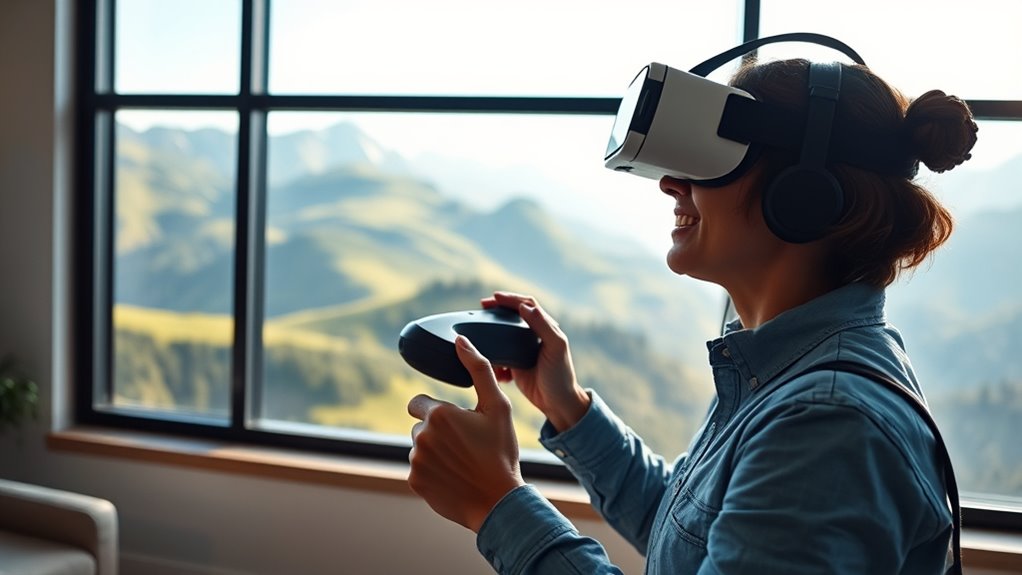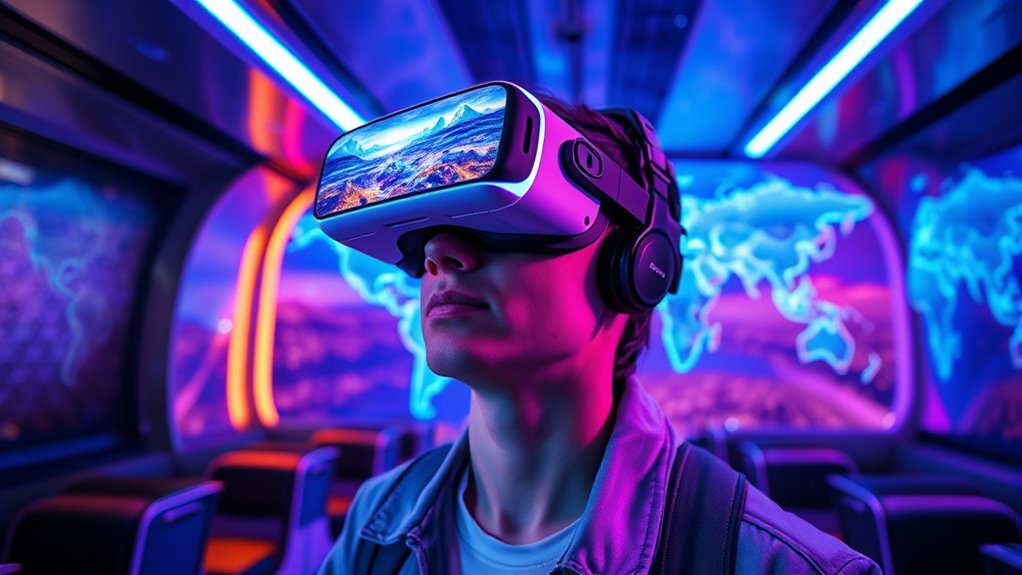Virtual reality is transforming travel by offering immersive, accessible experiences that let you explore destinations from anywhere. With advancements in VR, AR, and AI, you can enjoy realistic virtual tours, previews, and even cultural immersions that enhance your travel planning and enjoyment. This technology makes exploring more interactive and personalized, promising a future where virtual journeys are a key part of travel experiences. Keep exploring to discover how this frontier continues to evolve and impact your adventures.
Key Takeaways
- Virtual reality is transforming travel by offering immersive, accessible virtual tours that complement or substitute physical trips.
- Advancements in VR, AR, and AI enhance realism, interactivity, and personalization of virtual travel experiences.
- The industry is rapidly growing, projected to reach nearly $29 billion by 2035, driven by increased internet and device penetration.
- VR enables remote exploration of destinations, cultural sites, and hotels, benefiting travelers, students, and businesses alike.
- Future developments will make virtual tourism a key component of travel, eco-friendly, and highly engaging, reshaping the travel industry.

Virtual reality is transforming the way you explore travel destinations, offering immersive experiences without leaving your home. The virtual tourism market is booming, with projections showing a remarkable growth rate of 33% annually from 2023 to 2030. By 2025, the industry was valued at around USD 14.2 billion, and it’s expected to nearly double by 2035, reaching USD 29.1 billion. This rapid expansion reflects how VR is reshaping travel, making it more accessible, customizable, and environmentally friendly. As internet penetration and smartphone usage increase worldwide, more people are turning to virtual experiences to satisfy their wanderlust.
Virtual reality is revolutionizing travel by making destinations accessible, immersive, and eco-friendly through rapid growth in the virtual tourism market.
The key drivers behind this growth include the desire for personalized holidays and the demand for unique, experiential travel options. You can now explore distant landmarks, cultural sites, and scenic landscapes through 360-degree videos and virtual tours that feel incredibly real. Advancements in VR, AR, and AI technologies have considerably enhanced these experiences, making them more immersive and interactive. For example, spatial audio and haptic feedback add layers of realism, so you feel as if you’re truly walking through ancient ruins or floating above a city skyline. The integration of 3D scanning, photogrammetry, and computer vision helps create highly detailed and accurate virtual environments, further elevating your sense of presence. Additionally, technological innovations continue to push the boundaries of what virtual tourism can offer. These innovations are supported by ongoing research into virtual engagement strategies that increase user satisfaction and immersion. Furthermore, user interface design is evolving to make virtual experiences more intuitive and accessible for people of all ages and technical backgrounds.
Market segmentation reveals a variety of offerings tailored to different needs. Whether it’s 360 virtual tours, 3D virtual environments, or fully immersive VR journeys, options are expanding across cloud-based and web-based platforms. These solutions are used by airlines, hotels, and tour operators to provide virtual previews or to supplement traditional travel services. End-users range from leisure travelers seeking escapism to students exploring historical sites remotely. Cultural institutions and educational organizations leverage virtual tourism for remote learning, while businesses incorporate it into training and team-building exercises. Health sectors also utilize VR for therapeutic purposes, enhancing wellbeing through immersive environments. Research indicates that the adoption of VR in tourism has led to increased engagement and interest among potential travelers, which can translate into actual bookings and visits. Moreover, ongoing innovations in visual fidelity continue to improve realism, making virtual tourism an even more compelling substitute or supplement to physical travel. Looking forward, the integration of AI and interactive features promises even more personalized and engaging experiences. As 5G networks and smart devices become widespread, virtual tourism will become more seamless, realistic, and accessible for everyone. With such rapid technological progress, VR is poised to become a fundamental part of your travel journey, offering endless opportunities to explore the world from wherever you are.
Frequently Asked Questions
How Affordable Is Virtual Reality Travel Compared to Traditional Trips?
You wonder how virtual reality travel compares in affordability to traditional trips. VR experiences typically involve high initial setup costs, like $1,500 to $3,000 for equipment, but then offer cheaper ongoing expenses. In contrast, a traditional trip costs around $7,600. Virtual travel allows you to explore destinations multiple times at a fraction of the cost, making it a more economical option while still providing immersive experiences.
Can Virtual Reality Replace Actual Travel Experiences Completely?
You wonder if virtual reality can replace actual travel experiences completely. While VR offers impressive previews and accessibility, it can’t match the sensory richness and cultural immersion of real travel. You miss out on physical sensations, authentic interactions, and spontaneous discoveries. VR is a valuable supplement, but it’s unlikely to fully replace the depth and authenticity that come from stepping into a new environment firsthand.
What Are the Technical Requirements for an Immersive VR Travel Experience?
You need a powerful setup for an immersive VR travel experience. Confirm your computer has at least 8GB RAM, a high-performance GPU like NVIDIA GeForce RTX 3060, and a multi-core CPU such as an Intel Core i7. Use an SSD for quick loading, and check that your operating system and drivers are up to date. Make certain your VR headset is compatible, and optimize your content for smooth, realistic interactions.
How Do VR Travel Experiences Impact Local Tourism Industries?
Oh, so you wanna know how VR travel impacts local tourism industries? Well, it’s a game-changer! You get more visitors exploring remotely, which can boost interest without a single footstep. Local businesses find new revenue streams, jobs spring up, and destinations stand out from the crowd. Just remember, while VR draws people in virtually, the real-world charm still needs some love to keep tourists coming back in person.
Are There Health Risks Associated With Prolonged VR Travel Sessions?
You should know that prolonged VR travel sessions come with health risks. You might experience eye strain, headaches, or motion sickness if you stay immersed for too long. Fatigue and neck strain are also common concerns. To stay safe, take regular breaks, adjust your headset settings, and choose content with low motion intensity. Being mindful of your body’s signals helps prevent discomfort and maintains your overall well-being during extended VR use.
Conclusion
Imagine stepping into a virtual world where you can wander ancient streets, feel the breeze on a mountain peak, or swim coral reefs—all from your living room. Virtual reality transforms travel into an immersive adventure, breaking down barriers of distance and cost. As you put on the headset, you’re not just observing; you’re experiencing. The future of travel is here, inviting you to explore new horizons without ever leaving home. Are you ready to take the leap?









